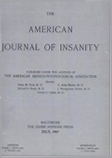NEW ENGLAND SOCIETY OF PSYCHIATRY
Abstract
(1) The psycho-physical element is still a matter of theory.
(2) Sensory aphasia both anatomically and clinically is universally accepted.
(3) Visual aphasia is well established anatomically and clinically, although the connection between the anatomical and clinical is variously explained.
(4) Cortical motor aphasia as defined above is firmly established clinically and anatomically.
(5) Subcortical aphasias clinically and anatomically must be accepted.
(6) The zone of speech is a unit composed of partial systems whose relative independence and development vary in different individuals.
(7) Loss of word concepts always causes intellectual defect.
(8) The limit of knowledge to be gained by present methods of clinical and anatomo-pathological examination has not been attained. We especially need complete examinations on intelligent cases capable of introspection with clear-cut lesions.
Access content
To read the fulltext, please use one of the options below to sign in or purchase access.- Personal login
- Institutional Login
- Sign in via OpenAthens
- Register for access
-
Please login/register if you wish to pair your device and check access availability.
Not a subscriber?
PsychiatryOnline subscription options offer access to the DSM-5 library, books, journals, CME, and patient resources. This all-in-one virtual library provides psychiatrists and mental health professionals with key resources for diagnosis, treatment, research, and professional development.
Need more help? PsychiatryOnline Customer Service may be reached by emailing [email protected] or by calling 800-368-5777 (in the U.S.) or 703-907-7322 (outside the U.S.).



